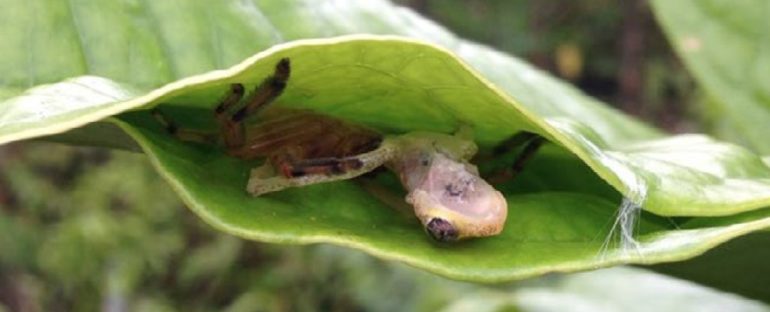As if spiders weren’t already crafty enough, on the island of Madagascar, biologists have now found what appear to be frog traps crafted by huntsman spiders (Damastes sp.).
The so-called traps were made from leaves stitched together with silk, and potentially offered shady spots for amphibians to rest, resulting in them getting trapped in the web and becoming a spider snack.
To be fair, calling them frog traps is for now rather speculative. This paper is based on a single observation of a spider chowing down on a half-wrapped frog (Heterixalus andrakata).
And in this case, the spider wasn’t even eating the frog inside the trap, but next to a pair of leaves conveniently stitched into a shady hollow. Though the spider did slink back into the pocket for some privacy while being studied.
But keeping in mind the possibilities of coincidence and sheer opportunism, there are some good reasons to suspect the structures are examples of a tool intended to lure small amphibians in from the harsh midday sun.
“Previous reports of spiders preying on amphibians point to an opportunistic behaviour and provide no evidence of specialisation,” write the researchers, which includes biologists from the University of Antananarivo in Madagascar and the University of Goettingen in Germany.
“Based on our report, we speculate that the spiders use targeted traps to prey on amphibians.”
Building retreats as a means of hiding from predators isn’t exactly a rare behaviour among spiders.
In this specific case, a total of four different retreats were found, all created by individual spiders sewing the edges of two adjacent leaves on one of three different species of living tree, leaving a narrow space the spider could withdraw into.
Of course, it could just be a cool spot for the arachnid to hide from both the intense tropical heat and predators.
But spending so much silk and effort on a leaf sandwich just to chill out for a while makes little sense when there’s plenty of ‘free’ options in the form of natural hollows and dense foliage around to serve a similar, if slightly less luxurious, purpose.
Having a nutritious reward for all that hard work would at least serve as some compensation. And who would be more grateful for a secure hidey-hole than a tiny thin-skinned frog desperate for cover?
“Based on these strings of evidence, we speculate that amphibians may not only be an opportunistic, indiscriminate, or accidental prey, but rather a targeted systematically exploited food source of Damastes sp. spiders,” the researchers suggest.
Intention is a tricky thing to define in biology. While humans regularly develop technology with an explicit purpose, evolution is often far more haphazard. There’s no reason to think the shelters don’t meet several needs, including a safe-space for the spider architect.
Since around half of an animal’s energy is routinely spent on actively finding more energy, having some way to bring food right to your door would certainly be a strong influence on behaviour. So it might not take a lot of froggy snacks to make it worthwhile for the spider, either.
It’s not the first time a spider has been seen consuming a frog on the island. While vertebrates aren’t an arachnid’s usual prey, there are enough examples around the world to make it clear it can be well worth the effort.
Finding more examples of large prey being eaten inside, or even nearby other cool leaf-caves would certainly go some way to suggest the spiders have adapted their crafting technique to welcome the occasional shade-seeker.
Given the ingenuity of spiders around the world, would we really be all that surprised?
This research was published in Ecology and Evolution.



